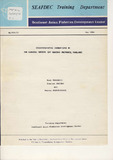| dc.description.abstract | This paper discusses the oceanographic conditions in the coastal waters off Rayong Province, Thailand, based on the data collected during the survey from 15 to 21 October 1984. The details of the discussion can be summed up as follows:
(1) The central depression of the Gulf was separated from the coastal waters off Rayong Province by a ridge at a depth of 16 meters.
(2) The distribution of fine calcareous biogenic remains in the sediments were concentrated in the steeper slope zone between 16 to 22 meters in depth.
(3) The grain size distribution of sediment in the waters falls roughly into two grounds separated by the 22 meters depth contour. One is the sandy area extending shoreward form the contour. Its configuration was irregular. The other is the muddy area un the depression deeper than 22 maters. Its configuration was flat. The sandy area could be further subdivided into two group: one was a calcareous sandy area and the other was a sandy area, according to the calcium carbonate content of the samples. The narrow transition zone between the sandy coastal and the muddy depression areas were occupied by the calcareous sandy sediment.
(4) We could determine that each type of sediment distribution in the sea was characterized by the hydrodynamics condition.
(5) It seemed that the five meters depth, in the waters off Ban Phe, indicated the limited depth of wave disturbance on the bottom from the point of new of hydrodynamics.
(6) A considerably high current velocity occurred in the surface layer around Man Nai Island during the period of low tide. The direction of the current changed frequently in 24 hours and no dominant direction could be found. This indicated that the observation area was in waters with eddies.
(7) We observed a certain phase of the collision of water masses with different salinities. One was a high salinity oceanic water mass originating from the South China Sea and the other was a low salinity coastal water mass.
(8) The oceanographic structure determining the squid fishing grounds in these waters; has the following features:
(a) Depth is 15 to 30 meters for squid;
(b) Bottom topography is steeper slope zone;
(c) Bottom sediment along the coast consists of abundant fine calcareous biogenic remains;
(d) Squid is attracted to the stagnant waters or eddies. | en |

